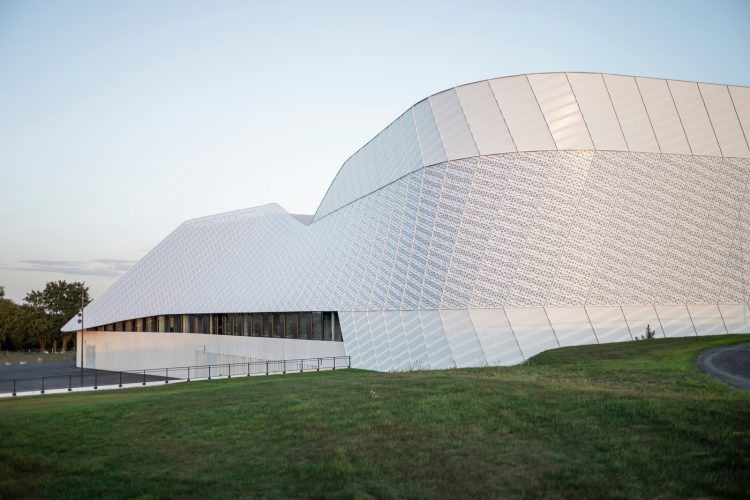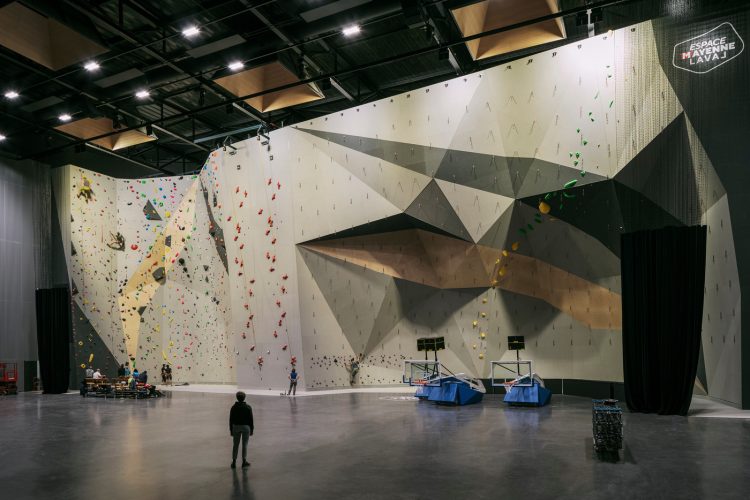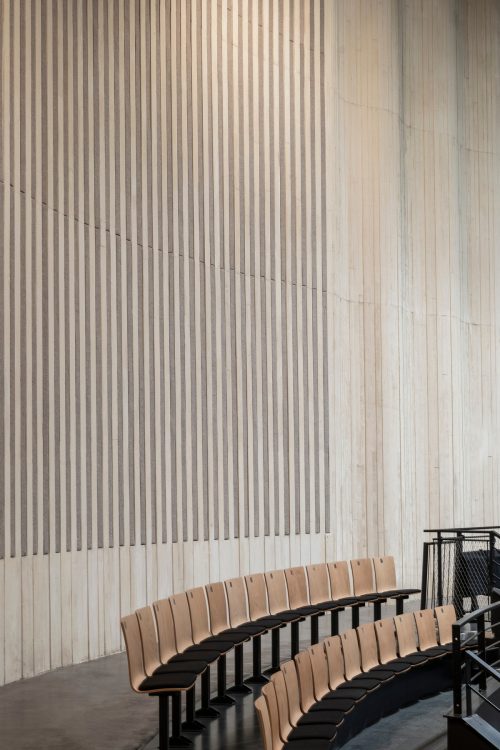Sports and Entertainment Venue "Espace Mayenne" by Hérault Arnod Architectures
Espace Mayenne is a multifunctional facility including a large sports and entertainment venue with a capacity of 4,500, a gymnasium with a climbing wall for international competitions, and a conference hall. In addition to these three main venues can be found other spaces, such as partner lounges designed as modular rooms to receive guests during games or shows, as well as offices and cloakrooms for artists and sportsmen. Outside the building, the project is completed by a 670-space parking lot, a landscaped area, and a 250-meter-long cycling ring for national competitions integrating a training track in its center.
The site
Espace Mayenne is located in a former military site bordering the French city of Laval, along the D900 urban ring road. The project began with an urban and landscape study aiming to define guidelines for the future development of this site in accordance with the framework of the Ferrié new neighborhood. This is an area undergoing change, crucial to the dynamic revitalization of the city. The building’s organization respects the landscape structure and the memory of the site, combining ecology, compactness, economy of means, and the creation of a mass plan saving parcels for future programs. The landscape heritage of the site is remarkable. It is composed of a natural area - marshes, woodlands, and wet meadow - and an old bocage grid with sculptural trees and sunken lanes, which are all entirely preserved. An east-west pedestrian-bicycle path is created to structure the site, crossing the public parking lot and the wetland, before widening itself in front of the building into an entrance piazza.
The building
To participate in the economy of soils and shape optimization, the building is a unitary volume that envelops the three venues in one movement. The organic aspect of the building stems from its conception. It is less of a design gesture than the consequence of a process that articulates the three halls on a singular landscape. The façade is like a skin wrapping itself around the rooms, resulting in a shifting shape that constantly changes depending on the viewpoint. It is composed of three horizontally stacked stripes that deform themselves in order to envelop the volumes as tightly as possible. These three ribbons overlap and rotate around the building, generating fluidity, unity, and movement. Together, they create a flexible plane covering the entire height of the building and sometimes elevating itself in certain points in order to uncover glazed façades. Its complex form is subdivided into simple, identical geometric elements allowing a rational construction using textured aluminum plates.
The lobby
The lobby is designed within the interstitial space between the three main venues. Its organization allows a fluid circulation of the different public flows according to various scenarios of occupation - the three venues can be in use at the same time or not. The lobby is characterized by its inverted conch-shaped volume and its acoustic ceiling made of wooden boards. The building has two ground floors and is organized so that the different types of flows - public, sportsmen, technicians, artists, staff, and partners - are clearly separated.
The sports and entertainment grand hall
The functional organization of the building responds to its multiple uses. The design of the convertible grand hall is induced by its need for versatility as it must be functional for shows, concerts as well as for sports games. While sports events require an arena system where the spectators are sitting all around the field, concerts and shows require a frontal system with a stage. The room is asymmetrical with a large balcony on one side, which allows the installation of a stage on the long north side, therefore reducing the distance between the performers and the public. Diagonal curtains can be drawn to transform the arena configuration into a trapezium that flares out starting from the stage frame. In the sports events’ configuration, the field is closely surrounded by an arena of bleachers.
The technical treatment of this hall has been thought out so that it can be quickly converted from one configuration to another: the space is completely transformed according to the program. The design of the walls, alternating between raw white concrete and wool felt, was elaborated in collaboration with acousticians. Areas of sound absorption, reverberation, or a mix of both were defined: corrugated raw concrete to distribute the sound in the space, strips of concrete alternating with strips of wool felt for the mixed areas, wool felt stretched with an acoustic mat for the absorbing zones, behind the bleachers. Suspended panels of wool felt were designed for the ceiling, creating an aerial geometric pattern. A vast technical grid is hidden behind them, allowing a great flexibility of equipment and scenic arrangements.
About Hérault Arnod Architectures
Hérault Arnod Architectures is a Parisian architectural studio founded in the early 1990’s in Grenoble by Yves Arnod and Isabel Hérault. The team is composed of fifteen architects with different profiles and from different nationalities who share a demanding and prospective vision of architecture.
The studio works on a diversity of programs, from micro to macro, from small architectural objects to territorial scale projects such as working spaces, housing, or mixed-use buildings for both public and private clients. Hérault Arnod Architectures developed a specific expertise in the architecture of public venues, which often involve large numbers of visitors and flows, whether it is for concert halls and congresses, theaters, or large sports and cultural facilities. The studio’s main on-going projects are a mixed-use building (animation cinema school, offices, student residences) in Cesson-Sévigné; the MuMO museum-truck for the Centre Georges Pompidou; the reconversion of a 1960’s building in the center of Lyon with an extension with a timber structure; and an office building in Saint-Jacques-de-la-Lande made out of a timber structure, etc.

 English
English 日本語
日本語










